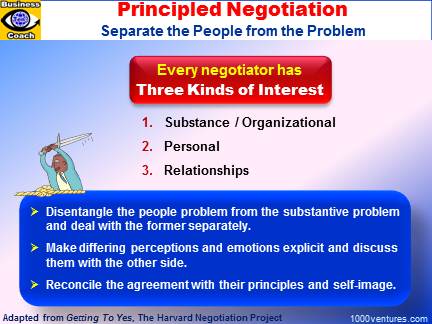|
How to deal with a substantive
problem
and maintain a good working relationship

→
Negotiation
DOs and DON'Ts
→
How To
Solve People Problems
→
Brainstorming:
10 Rules
|
Getting To Yes |
|
Be hard on the deal, soft on the
people...
More |
References:
1.
Getting to
Yes, by Roger
Fisher, William Urey, Bruce Patton, Harvard Negotiation Project
2.
Secrets of Power Negotiating, Roger Dawson |
A
Common Problem To Be Solved
→
Dealing with a problem
 is often aggravated by
people taking things personally, misunderstanding each other,
resisting
change, getting upset, angry or disinterested. Your counterparts may treat
your comments on the substance as facts about your intentions and attitudes
towards them. A
→
problem statement may be heard as a personal attack. Anger
over a problem may lead you to express discontent with a person associated
with it in your mind. is often aggravated by
people taking things personally, misunderstanding each other,
resisting
change, getting upset, angry or disinterested. Your counterparts may treat
your comments on the substance as facts about your intentions and attitudes
towards them. A
→
problem statement may be heard as a personal attack. Anger
over a problem may lead you to express discontent with a person associated
with it in your mind.
We tend to treat people and problem as one.
Substantive issues become entangled with psychological ones, and egos become
involved in substantive positions. The process is almost automatic if we
donít take care of it.
→
Turn Problems to Opportunities:
6 Tips
Separate the People from the Problem
"During a
negotiation, it would be wise not to take anything personally. If you leave
personalities out of it, you will be able to see opportunities more
objectively."
~ Brian Koslow
Every negotiator has three kinds of interests:
in the substance or organizational interests; personal interests; and the
relationships. Negotiators are people first with their values, emotions,
different backgrounds and viewpoints. In addition, with many long-term
associates, the ongoing relationship is often more important that the
outcome of a particular negotiation.
The good thing, according the authors of the
Getting to Yes1 guidebook sponsored by the Harvard Negotiation Project, is
that ďdealing with a substantive problem and maintaining a good working
relationship need not be conflicting goals if the parties are
committed and
psychologically prepared to treat each separately on its own legitimate
merits.Ē
Principled
negotiation,
as contrasted to positional bargaining, focuses on the interests of the
parties, mutually satisfactory options and fair standards to reach
agreement. It enables the parties to reach agreement efficiently without all
of the anger and resentment that occurs when they try to dig each other out
of entrenched positions, improving the chances for a
→
wise agreement,
amicably achieved, that can lead to a rewarding long-term relationship.
Donít try to
→
solve people problems with substantive concessions.
Deal with people problems directly using psychological techniques.
Different people do see the same things
differently. Make differing perceptions explicit and discuss them with the
other side in a frank and honest manner. To change their perceptions, send
them a message different from what they expect.
→
Creative Problem Solving
Recognize and
understand emotions, yours and
theirs. Make emotions explicit and acknowledge them as legitimate. Allow the
other side to let off steam, if required.
Communicate clearly. Speak to be understood and
show that you understand them. Listen actively and acknowledge what is being
said.
Respect the values and the reputation of your
counterparts and reconcile
the agreement with their principles and
self-image.
|